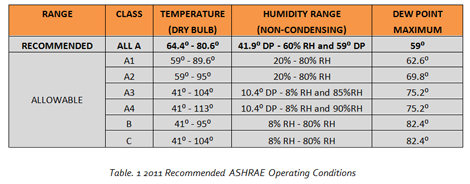Robert F. Sty, PE, SCPM, LEED AP is Principal of SmithGroupJJR’s Technologies Studio in Phoenix, AZ and focuses on the Architecture and Engineering design of mission-critical facilities. Robert is on LinkedIn.
Air side economizer systems, or “free air-side cooling” as it’s known, has gained popularity as energy efficiency has become a major factor in data center operation. When climate conditions are appropriate outside air is introduced into the data center for cooling purposes, and thereby, reducing the number of hours in which mechanical cooling is required. This strategy has led to an overall reduction in energy use and Power Usage Effectiveness (PUE) ratios.
In 2011, the American Society of Heating, Refrigeration, and Air Conditioning Engineers (ASHRAE) expanded their recommendations for allowable temperature and humidity conditions for server inlet temperatures. (See Table 1 below).
Introducing outside air into the data center in certain climates can offer significant energy savings, but it does add another set of variables to the control strategies in how the system reacts to maintain the recommended set points at the server inlet. Air side economizer cycles cannot be driven solely by dry bulb temperature conditions alone. The specific dry bulb temperatures may be suitable for full or partial economizer, but the amount of moisture in the air may require additional conditioning through either humidification or dehumidification strategies. This could offset potential energy savings and increase operational expenses.
The Issue: Relative Humidity or Dew Point?
Should the data center mechanical systems respond to Relative Humidity or should Dew Point temperature sensors be used? There is little argument that Dew Point sensors will give a more accurate depiction of the moisture content of the air stream but to many it’s unclear just why that is. Relative Humidity (RH) is just that, relative. It is a ratio of the amount of moisture in the air compared to how much moisture could possibly be in the air at a given temperature and pressure. It is typically identified as a percentage which is fairly easy to understand.
If the RH percentage rises while holding temperature constant then it is logical that the amount of moisture in the air has also increased. However, if the temperature has increased or decreased, the RH percentage can also increase or decrease without any moisture added or removed! The RH value is relative to the temperature of the air, and changes with that value.
The Dew Point temperature (DP) is a measurement of the true amount of moisture in the airstream. Should the temperature of the air fall below the dew point temperature condensate will form and collect on surfaces. In a sensible mode of heat transfer (processes staying above the dew point temperature) the amount of moisture in the air is not increased or decreased. This is the process which occurs as air passes from the inlet to the outlet of the server cabinet. Air temperature increases, but the amount of moisture in the air remains the same therefore dew point temperature remains the same.
Location, Location, Location
What effect does the type of control have on data center operation? Table 2 above highlights the percentage of hours of operation under various conditioning modes for five different cities. The DP Control column shows a strategy which controls to a dew point temperature window in the full range of recommended ASHRAE conditions (41.9⁰ DP - 60 percent RH and 59⁰ DP). The RH Control column shows a strategy which is also in the window of recommended conditions however it maintains a tighter RH level in the data center at 40-50 percent range, which many operators feel comfortable with. Both strategies assume a data center utilizing full and partial air side economizer strategies.
In each case it is noted that the number of hours per year of both humidification and dehumidification modes are increased by controlling to a specific RH range in lieu of controlling to a set dew point temperature range. Over the life of the data center, controlling to a specific and tight RH window can greatly increase the number of hours of required humidification/dehumidification cycles. This can lead to a large increase in operational expenses in energy and water treatment.
So is control of humidity through RH sensors instead of DP sensors wrong? Not necessarily. Both strategies can control supply air to the appropriate window of server inlet conditions as recommended by ASHRAE. It is important to note that per ASHRAE the risks of Electric Static Discharge (ESD) are impacted more by the absolute humidity level (as noted by the dew point temperature) versus the relative humidity levels of the air.
Also, one can see that controlling to a tight RH band can lead to an increase in hours of operation of the moisture control systems. By understanding the impacts of the specific control strategy data center managers and operators can select the preferred mode of control which suits their specific needs best.
Industry Perspectives is a content channel at Data Center Knowledge highlighting thought leadership in the data center arena. See our guidelines and submission process for information on participating. View previously published Industry Perspectives in our Knowledge Library.






